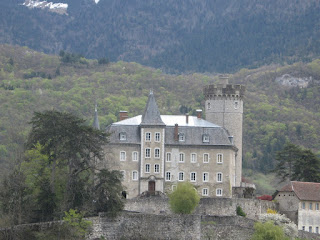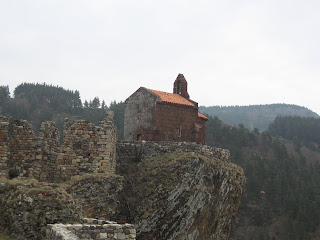
Chateau of Annecy

A flower bed near Lake Annecy
We're now in Annecy, in the Savoie region. Annecy has won the coveted 4 flowers (Ville Fleurie) so many times it has entered what is essentially the lifetime hall of fame. Above is a photo of just one of the hundreds of flower gardens or pots, and a photo of the Chateau of Annecy in the old center of the town.
After a long stretch without Internet access, and the first time on my own laptop in an even longer time, I have access at a public library here. Below is a recap of the last week or so, which I wrote as we went along our route.
On Saturday, April 4, we left our bed and breakfast in Chauzon and first stopped in Aubenas, which has a large Saturday market. Among the vendors whose products we bought was La Ferme au Chateau, a cheese producer from the village of Chastanet, near the town of Valgorge in the southern Ardeche, between Le Puy and Joyeuse. Over the next several days we had their cheese: a sheep blue less salty than Roquefort; a semi-aged soft sheep cheese; and an aged goat cheese log covered with cinders. After leaving Aubenas we had a picnic lunch on the way to the northern Ardeche, and also stopped briefly in Privas for a coffee at an outdoor café. We then continued on to our gite in the northern Ardeche. Our gite was one side of a two-story renovated old farm structure, located up in the hills between the towns of Ardoix and Sarras.
On Sunday we took a long drive to the morning market in St. Felicien, which turned out to have only a few cheese vendors and a boudin (blood pudding sausage) seller. In the afternoon we visited the Cave de Sarras, the nearby wine cooperative. The day before, the gite owner had given us a bottle of the Cave’s 2005 vin de pays Syrah rouge, which was made from young vines of the Syrah grape in the St. Joseph appellation. It was a terrific wine with roast chicken that we had purchased at a shop in Tournon, and then today we tasted the producer’s entire line of St. Joseph reds and whites, as well as their Condrieu. It was an exceptional array of wines, and we bought a bottle of their 2007 Condrieu and the 2005 St. Joseph ‘Cuvee Memoire’ rouge (atthe end of the week we went back and bought a bottle of one of their St. Joseph whites). Then we took a walk from the cooperative parking lot along the Ay river.
On Monday morning we went to a large outdoor market in St. Agreve, a large town in the mountains. After the market we drove south towards the Eurieux valley, then back to the gite for lunch. In the afternoon we visited Domaine Bernard Gripa, a wine producer just south of Tournon. We tasted several wines, including their fabulous St. Peray (2007 Cuvee ‘Les Figuiers’; 60% Rousanne/40% Marsanne) and St. Joseph (2007 Cuvee ‘Le Berceau’; 100% Marsanne) white wines, and bought a bottle of each. Afterwards, we walked along, and then across, the Rhone River in Tournon.
The next morning we drove to the outdoor market in the small town of Satilleau, where we picked up a few provisions. At Maison Crouzet, a “charcuterie ardechoise” in the center of the village, we bought steak for dinner, as well as grillitons, a rillette-like pork product. The closest parallel to pork rillette in the United States is probably North Carolina pulled pork barbeque, but rillette is fattier yet more refined, and is meant to be eaten at room temperature. The boulangerie/pattisserie in town, Maison Roux (phiroux@aol.com), with its young baker, makes fabulous breads and pastries, including the two amazing chocolate pastries we had at lunch at our gite We walked around Satilleau for awhile, took some photos of the 19th century church and the old center of village, then drove up the mountain to La Louvesq, a walking/hiking center. We went into the St. Regis church (where the bones of St. Regis reside), and took some pictures of the exterior as well as of the surrounding valley. In the afternoon we drove to Tain l’Hermitage to the large, reputable cooperative, Cave de Tain, where we tried a wide array of their wines. We bought a bottle of their 2005 Crozes-Hermitage ‘Les Hauts de Fiefs’ rouge, and their 2003 Hermitage blanc.
On Wednesday we went to the morning market in the large town of Annonay. The market itself was fairly small, with mainly local farms selling their own produce, but the town had every type of food shop imaginable to supplement the market. We bought a roasted farm chicken for lunch, along with some produce from the market vendors, including local white asparagus. In the center of town we stopped at a fish monger to pick up some fish to cook for dinner, and also stopped at a food and wine shop that had a great selection of wine from the Rhone and elsewhere. We bought a bottle of the 2008 Morgues du Gres ‘Fleurs d’Eglantine’ rose, which has ben a favorite of ours in past vintages. In the afternoon we took a drive north towards Condrieu and stopped at Domaine Pierre Gaillard in the village of Mallval. At this domaine we tried a wide range of wines, including red and white St. Joseph, a fabulous white Cotes du Rhone made entirely from Viognier, and their Cote Rotie, Cornas, and Condrieu wines. Pierre Gaillard is also a partner in an estate in the Roussillon region of France, Domaine Madeloc, and we tried their outstanding Banyuls. We bought quite a bit here, including the white Cotes du Rhone and a terrific white St. Joseph.
On Thursday we had a morning appointment at Domaine Belle, a small wine producer in the village of Larnage near the town of Crozes-Hermitage. The visit was arranged by Carole Decouard, Bobby Kacher’s New England representative, and we tasted the entire range of their wines with Philippe Belle, the owner/winemaker. Their wines, which include both reds and whites from the appellations of St. Joseph, Crozes-Hermitage, and Hermitage, were spectacular, particularly the reds. All of the red AOC’s are based entirely on the Syrah grape, yet each wine was very different from every other one, graphically demonstrating the significance of the illusive concept of terroir. Particularly fascinating was the cassis aroma and flavor of the St. Joseph, which we had not encountered in any of the Syrah-based wines we tried on this trip.
At lunch at our gite, after first stopping in Tournon following the tasting at Domaine Belle, we opened a bottle of the 2007 Pierre Gaillard Cotes du Rhone Blanc, made entirely of Viognier. It was truly exceptional; probably the best white Cotes du Rhone I’ve ever had, and as good or better than any Viognier I’ve had, including those from the prestigious Condrieu appellation. In the afternoon we wandered through the winding roads in the area where we were staying, then drove to the nearby village of Ozon, where there is an amazing view of the Rhone River far below, stretching both north and south.
On Friday morning we headed off to Burgundy, where we were meeting Ghisilane, a friend whom we met through Jim and Cathy Baxter (the British couple we stayed with at the start of our trip), as well as the Baxters’ daughter, Lindsay, who was visiting Ghisilane and her husband during her break from nursing school (We had last seen Lindsay several years ago when she stayed with us in Portland). We met Ghisilane and Lindsay in Macon, a busy commercial center, where we had lunch. After lunch we followed Ghisilane through the hills of southern Burgundy, where we stopped at two wine producers in the Maconnais region. Then we left the Maconnais and drove through part of the Beaujolais region, through some of the wine villages such as Morgon and Brouilly. Ghisilane then took us to a producer in the village of Regnie-Durette that she had visited once before with her husband, and which her husband frequently visited with their sons. We were met by the proprietors, Gabrielle and Claude Rey, who sat down with us and poured several of their wines while they chatted with Ghisilane. The Reys produce red wines in the Regnie and Morgon appellations of Beaujolais, and also make a Beaujolais-Villages rose. We tried an oak-aged 2007 Regnie, and a newly-bottled unoaked 2008 Morgon, as well as a rose. The wines were among the finest examples of Beaujolais I’ve ever encountered. The wonderful Gamay fruit showed through, even with the oak-aged wine; far superior to the mass produced Beaujolais that one generally encounters in the United States.

Tasting in the cellar with the Reys
On Saturday, April 11, after cleaning up our gite and saying goodbye to the owner, we drove to Annecy for our next stay. It was the day before Easter, and also in the middle of school holidays for many Europeans, so the roads were jammed with traffic. We finally made it to Annecy a little after noon, dropped everything off at the apartment we were renting, and returned the rental car (a somewhat harrowing experience, which I won’t go into). Once we finally got settled in, we realized what an amazing site Annecy has along the lake (Lac Annecy). The apartment we were renting for a week was in a nondescript building right on the main road along the lake, but the apartment itself was charming inside, and it had a great terrace with a table and chairs for dining outside while looking over the lake towards the mountains, and also towards the chateau and cathedral in the center of town.
That afternoon we walked along the lake towards the center of Annecy (a walk we were to make several times over the next few days), then wandered through the town, first up the pedestrian area that cuts right through the center, then into the very old part of town. In the pedestrian walking area we stopped at a fromagerie (cheese shop) where the owner showed us their ageing room below the shop. We bought several Savoie cheeses, and also a bottle of a local white wine, an Apremont from Domaine Blard et Fils. We drank the wine later in the day sitting on our terrace; it was a light, flavorful refreshing wine made from the obscure Jacquard grape, and at 11% alcohol it went down very easily.

The view from our terrace in Annecy


































